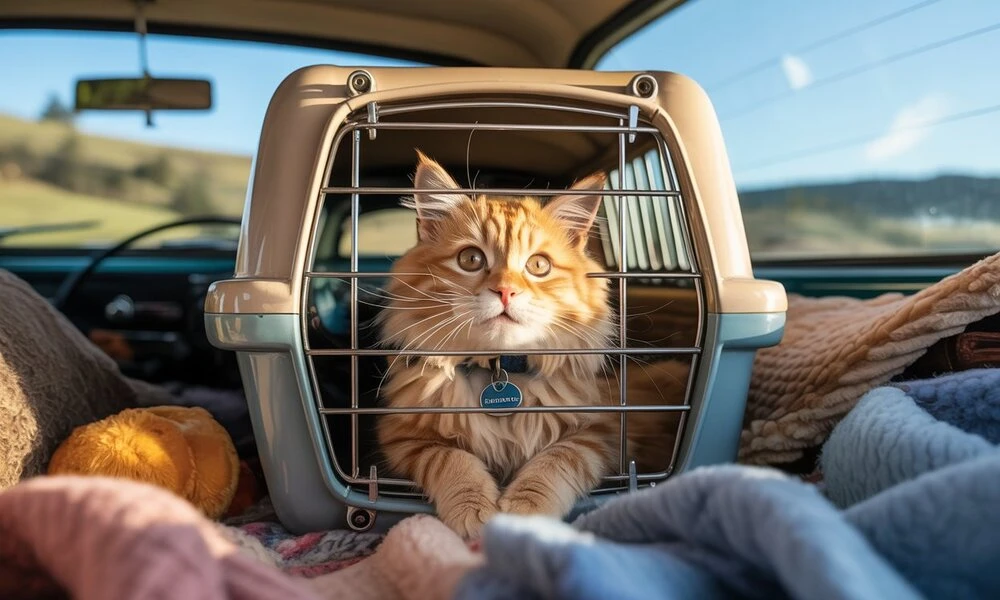How do you move cats across country without causing them stress or discomfort? Moving cross country with cats can be challenging, as cats are sensitive to change and travel. Choosing the right transport method is key—flying offers speed, while driving gives you more control. Each has its pros and cons depending on your cat’s temperament and health. A successful cross country move with cats requires preparation, patience, and attention to detail. This guide covers the two main transport options—flying vs. driving—and offers tips for planning, travel day, and settling in. With the right approach, your cat can arrive safely and comfortably.
Preparing Your Cat for the Big Move

Moving cross country with cats can be a stressful experience—for both you and your feline companion. Due to their habitual nature, cats can become agitated by even minor changes. When it comes to moving cats across country, early preparation is key to ensuring a smooth transition. Here’s how you can help your cat feel secure, comfortable, and ready for the journey.
The Importance of Early Preparation
Cats are highly sensitive to environmental changes. That’s why it’s crucial to start preparing weeks—or even months—in advance. Introduce your cat to moving-related items like boxes, packing tape, and suitcases gradually so they can acclimate without becoming overwhelmed. Early prep also gives you time to address any health, behavioral, or logistical concerns before the big day arrives.
Vet Check-Up and Health Certificate
Before moving cross country with cats, schedule a visit to the vet. This ensures your pet is in good health and up-to-date on vaccinations. Many states require a health certificate if you’re traveling across state lines, especially by plane. It’s best to confirm travel requirements ahead of time to avoid complications.
Microchipping and ID Tags
One of the biggest fears when moving cats across country is the risk of them getting lost. Ensure your cat is microchipped, and that the information is current. A collar with an ID tag that includes your contact details (and possibly a temporary address or travel info) adds another layer of safety.
Crate Training: Helping Your Cat Feel Safe in a Carrier
A well-trained cat carrier can make a world of difference. Start crate training well in advance. Let your cat explore the carrier freely by placing it in a favorite room with the door open. Add treats, toys, or soft bedding to create positive associations. Gradually increase the time your cat spends inside to build comfort and trust.
Managing Anxiety: Pheromones, Calming Sprays, or Vet-Prescribed Sedatives
Moving cross country with cats can spike anxiety levels. To ease their stress, consider using feline pheromone diffusers or sprays (like Feliway) in their crate or temporary living space. For highly anxious cats, consult your vet about calming treats or sedatives designed specifically for travel. Never give your cat medication without first consulting a specialist.
You can read about our moving services in Los Angeles.
Tips for Flying with Your Cat
Flying with your cat can be stressful, but with some planning, it can be a smooth experience—especially if you’re moving cats across country. Here’s how to prepare:
1. Airline Policies and Pet Travel Regulations
Always check your airline’s pet travel regulations in advance. Not all airlines allow pets in the cabin, and those that do often have specific carrier size and weight limits. You’ll also need a health certificate from your vet, especially when moving cats across country.
2. Carrier Requirements & In-Cabin vs. Cargo
Make use of a soft-sided carrier that fits beneath the seat and has been approved by the airline. In-cabin travel is the best way to move a cat across country—it’s safer and less stressful than cargo. Select a direct flight and be sure to clearly identify the carrier if cargo is your sole choice.
3. Feeding, Hydration & Litter Box Planning
Feed your cat about 4–6 hours before the flight to avoid nausea. Offer water regularly but in small amounts. In the event of an accident, line the carrier with an absorbent pad. Consider using a travel litter box before heading to the airport.
4. At the Airport: Navigating Security & Boarding
At security, you’ll need to take your cat out of the carrier and carry them through the scanner. Use a harness to prevent escape. Board early if allowed, and keep the carrier under the seat in front of you.
5. Keeping Your Cat Calm During the Flight
Familiarize your cat with the carrier before the trip. Use calming sprays or pheromone wipes. Avoid opening the carrier in midair and speak quietly. Ask your veterinarian about sedatives for pets who are nervous.
With preparation, the best way to move a cat across country is by keeping them close, calm, and cared for throughout the journey.
Choosing the Right Flight When Moving Cats Across Country

When moving cross country with cats, selecting the right flight can make a big difference in your cat’s comfort and safety.
1. Best Airlines for Pet Travel
Not all airlines are equally pet-friendly. Alaska Airlines, JetBlue, and Delta are often recommended for moving cats across country due to their reliable in-cabin pet policies and reasonable fees. Always check their rules before booking.
2. Booking Direct Flights to Reduce Stress
A direct flight is the best way to move a cat across country. It limits your cat’s travel time and avoids the stress of layovers and transfers. Fewer transitions mean a smoother trip for both of you.
3. Ideal Flight Times and Weather Considerations
Choose early morning or late evening flights during summer, and midday flights during winter, to avoid temperature extremes. If you’re moving cross country with cats, plan around mild weather to keep your cat comfortable.
4. Pet Travel Fees and Reservation Process
Most airlines charge around $95–$125 for in-cabin pets. Book early—only a limited number of pets are allowed per flight. When moving cats across country, call the airline directly to confirm your pet’s spot and ask about specific requirements.
A calm, direct, and well-timed flight on a pet-friendly airline is key to successfully moving cross country with cats.
For packing services in Los Angeles contact Chamomile Go.
Driving with Your Cat | On Roads
When moving cats across country by car, preparation is key to a safe and calm journey.
1. Vehicle Prep & Cat-Proofing
Secure loose items and block hiding spots. Keep windows closed and lock doors to avoid accidental openings.
2. Best Travel Carriers
Use a sturdy, well-ventilated carrier large enough for your cat to turn around. Hard-sided or soft carriers with seatbelt loops work best for long drives.
3. Comfortable Travel Routine
Plan regular stops every 2–4 hours for water, feeding, and litter box breaks. Stick to familiar food and maintain a calm tone.
4. Safety First
Never let your cat roam free in the car. Always keep them in their carrier, securely strapped in, for everyone’s safety.
5. Motion Sickness & Stress
Try pheromone sprays or calming treats. If your cat shows signs of distress, ask your vet about anti-nausea or anti-anxiety options.
Driving can be the best way to move a cat across country—as long as safety and comfort come first.
How to Transport Cats Across Country
When moving cross country with cats, choosing the right method of transportation is crucial for their safety and comfort. Here’s what to consider:
1. Flying vs. Driving
Flying is faster and ideal for long distances, especially if your cat can travel in-cabin. Driving offers more control, flexibility, and time to monitor your cat. The best way to move a cat across country depends on your cat’s temperament, your timeline, and budget.
2. Pet Relocation Services
Professional pet movers handle logistics, paperwork, and care during travel. They’re helpful if you’re unable to travel with your pet or have multiple cats. Consider this option for stress-free moving cross country with cats.
3. Shipping by Ground Transport
Pet ground transport companies offer door-to-door service with frequent stops, climate-controlled vehicles, and regular updates. It’s slower than flying but may be better for nervous cats.
4. Cost Comparison
Flying (in-cabin) usually costs $100–$200. Driving includes gas, lodging, and supplies. Pet relocation or ground transport can range from $300 to over $1,000 depending on distance and service level. Choose what fits your budget and your cat’s needs.
5. Legal and Documentation Needs
Most states require a current rabies vaccination and a health certificate issued within 10 days of travel. Check regulations if you’re moving cross country with cats—especially when flying or using a professional service.
Ultimately, the best way to move a cat across country balances cost, safety, and your cat’s comfort.
Final Thoughts
Moving cats across country can be smooth with the right planning—whether you choose flying, driving, or using a professional service. The best way to move a cat across country depends on your pet’s needs and your travel setup. Still unsure? Chamomile Go is here to help! Contact us today for expert advice and personalized solutions. Let us make moving cross country with cats stress-free—for both of you.
FAQs
Is Flying Or Driving Less Stressful For Cats?
Driving tends to be less stressful for most cats since you’re with them the whole time and can take breaks. However, short, direct flights can be less time-consuming and safer for calm, travel-ready cats.
Can I Bring My Cat In The Airplane Cabin?
Yes, most major airlines allow cats in the cabin if they’re in an airline-approved carrier and meet weight requirements. Always check the airline’s specific pet policy in advance.
What Paperwork Do I Need To Move My Cat Across State Lines?
You’ll typically need a recent health certificate and proof of rabies vaccination. These must be issued by a licensed vet, usually within 10 days of travel.
What Are Pet Relocation Services And When Should I Use One?
Pet relocation companies handle logistics like booking, paperwork, and transport. They’re helpful if you’re not traveling with your cat or want professional support during a long-distance move.
How Can I Keep My Cat Calm During A Long Trip?
Use a familiar carrier, pack comfort items (blanket, toy), and consider pheromone sprays. Some cats may benefit from calming treats or vet-prescribed sedatives.








